




Advanced Search
Dress Up | 1st Person | African American Map | Now Read This | Magic Lens | Tool Videos | Architecture | e-Postcards | Chronologies
Ray Elliot - 1939-1945: "Two Wars to Win"The Double V symbol inspires the fight against fascism abroad and racism at homeLike his father before him, Ray Elliott served in a segregated military. African Americans across the nation decided that they would defer their own fight for civil rights until and only until the world war was won… Learn more about Ray Elliot: View a timeline of his life and listen to his full interview. Stories by this speaker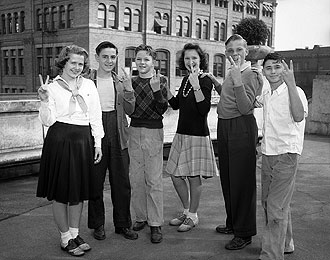
Winston Churchill's "V" for victory sign became a ubiquitous symbol of the unified approach that political leaders as well as regular people took toward the war. In this photograph taken in 1942, a group of Tacoma, Washington, teenagers display the victory sign. In January 1942, James G. Thompson, wrote a letter to the African American newspaper The Pittsburgh Courier in which he reflected upon the dilemma that he and other black people faced as they contemplated what their role in the Second World War would be: Being an American of dark complexion and some 26 years, these questions flash through my mind: Should I sacrifice my life to live half American? Will things be better for the next generation in the peace to follow? Would it be demanding too much to demand full citizenship rights in exchange for the sacrificing of my life? Is the kind of America I know worth defending? Will America be a true and pure democracy after the war? Will Colored Americans suffer still the indignities that have been heaped upon them in the past? These and other questions need answering; I want to know, and I believe every colored American, who is thinking, wants to know... The V for victory sign is being displayed prominently in all so–called democratic countries which are fighting for victory over aggression, slavery, and tyranny. If this V sign means that to those now engaged in this great conflict, then let we colored Americans adopt the double V V for a double victory. The first V for victory over our enemies from without, the second V for victory over our enemies from within. For surely those who perpetrate these ugly prejudices here are seeking to destroy our democratic form of government just as surely as the Axis forces.1 In 1942, "'V' for Home and World Victory" was the slogan of the War Chest of Tacoma, a branch of the Community Chest, During WWII. Richards Studio Collection Series, Tacoma Public Library, D13517–1 Footnote 1. James G. Thompson, January 31, 1942 letter to The Pittsburgh Courier quoted by Sharon Shahid, Newseum senior writer in "Power of the Black Press" Newseum.org, retrieved March 20, 2009. 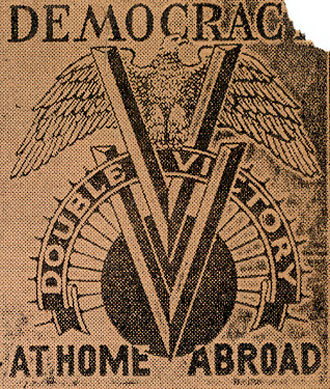
In response to James Thompson's letter, The Pittsburgh Courier published the above logo, without explanation, in early February 1942. The next week the paper reported: Last week, without any public announcement or fanfare, the editors of "The Courier" introduced its war slogan—;double "V" for a double victory to colored America. We did this advisedly because we wanted to test the response and popularity of such a slogan with our readers. The response has been overwhelming. Our office has been inundated with hundreds of telegrams and letters of congratulations, proving that without any explanation, this slogan represents the true battle cry of colored America. ... Americans all, are involved in a gigantic war effort to assure the victory for the cause of freedom–the four freedoms that have been so nobly expressed by President Roosevelt and Prime Minister Churchill....therefore we have adopted the Double "V" war cry–victory over...our enslavers at home and those abroad who would enslave us. WE HAVE A STAKE IN THIS FIGHT....WE ARE AMERICANS TOO!2 The "Double V" logo designed by the largest black newspaper of World War II, The Pittsburgh Courier, urged two victories for America. Pittsburgh Courier archives, used with permission. Footnote 2. Quoted in William F. Yurasko, "The Pittsburgh Courier during World War II, an Advocate for Freedom, VV campaign.org Website, retrieved May 19, 2009. 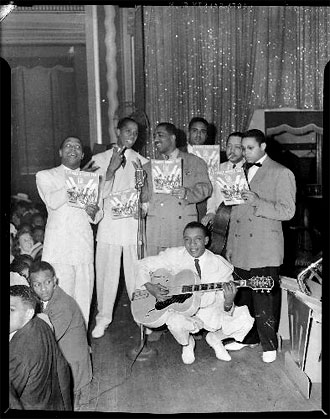
The vocal group, The Ink Spots, perform the song "Yankee Doodle Tan." Note the "Double V" illustration which dominates the cover of the sheet music, and the victory sign displayed by several of the singers. The Pittsburgh Courier aggressively promoted its "Double V" campaign. Historian Patrick Washburn describes the pervasiveness of the "Double V" in his interview for the PBS documentary The Black Press: Soldiers without Swords: Ah, it caught on to the—;to the extent that 200,000 blacks, ah, black people signed up for this thing by the summer of 1942, each one of 'em payin' The Pittsburgh Courier a nickel to belong to these Double V clubs, and you had women walking around with Double V's on their dresses. You had a new hairstyle called the Doubler where black women would walk around in weave two—;two V's in their hair. You had Double V baseball games, Double V flag–waving ceremonies, Double V gardens. I mean it's just Double V this, Double V this, Double V this. And The Pittsburgh Courier, which was looking for circulation, played this to the hilt...one–seventh of that newspaper, of their available space was the Double V and they played it to the hilt...There was even a Double V song. Charles 'Teenie' Harris, American, 1908–1998, Group portrait of the Ink Spots, James G. Thompson, Doc Wheeler, and Ken Bryan on far right, holding sheet music for "A Yankee Doodle Tan" with fingers signing V for victory, for Double V Campaign, Savoy Ballroom, 1942, H:4 x W:5 inches (H:10 x W:13 cm), Carnegie Museum of Art, Pittsburgh, Heinz Family Fund, Photograph © 2009 Carnegie Museum of Art, Pittsburgh. 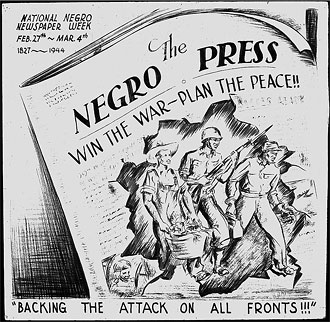
Charles Alston created "BACKING THE ATTACK ON ALL FRONTS!!!" for the Office of War Information in 1943. World War II dominated every aspect of American life. The war determined what an individual purchased, ate, saved, and donated. It oftentimes influenced where one worked and how one spent his or her free time. Charles Alston's illustration for "National Negro Newspaper Week" shows figures who represent the African American contribution to the agricultural, industrial, and military war fronts. As these advancing figures literally tear through the front page of the newspaper, Alston seems to promise that the "Negro Press" is the vehicle through which black Americans will not only help to "win the war", but will also "plan the peace," a peace that would no doubt include African American civil rights. Charles Alston, "BACKING THE ATTACK ON ALL FRONTS!!!" 1943, Office for Emergency Management. Office of War information. Domestic Operations Branch. News Bureau. National Archives, Series: Artworks and Mockups for Cartoons Promoting the War Effort and Original Sketches by Charles Alston, NAIL Control Number: NWDNS–208–COM–7. 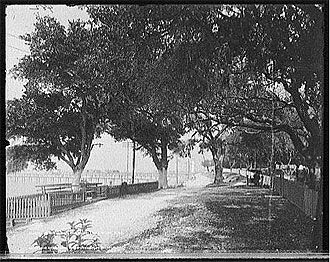
The above view of the Shell Road and Biloxi light house, Biloxi, Mississippi was photographed around 1901. During World War II, Ray received a part of his military training at a base in Biloxi, Mississippi. One day, despite prior warning, he accidentally drifted, alone, into Biloxi's white community and was confronted by a white man. When Ray responded "I'm from God's country" [meaning the north] to the man's derogatory question "Where you from, boy?" the crowd gathered around the two men was likely shocked. As a black man visiting from the north, Ray did not fully understand the reality of the unspoken but socially embedded rules that determined how black people and white people living in the south interacted with one another. Ray could not have known what Melba Pattillo Beals, a native of the south and one of the Little Rock Nine who integrated that city's Central High School in 1957, had experienced all of her life. She recalls of her girlhood: With the passage of time, I became increasingly aware of how all of the adults around me behaved the same. They were living with constant fear and apprehension. It felt as though we always had a white foot pressed against the back of our necks. I was feeling more and more vulnerable as I watched them continually struggle to solve the mystery of what white folks expected of them. They behaved as though it were an awful sin to overlook even one of those unspoken rules and step out of "their place," to cross some invisible line. And yet lots of discussions in my household were about how to cross that line, when to cross that line, and who could cross that line without getting hurt.3 Library of Congress, Prints and Photographs Division, Detroit Publishing Company Collection, LC–D4–1359 DLC. Footnote 3. Melba Pattillo Beals, Warriors Don't Cry: A Searing Memoir of the Battle to Integrate Little Rock's Central High (New York: Washington Square Press), 1994, 13–14. 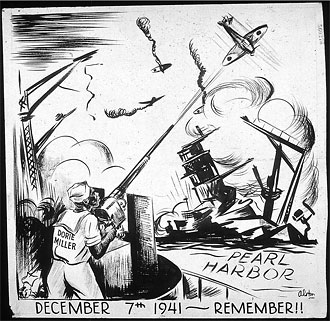
This cartoon, "DECEMBER 7th—;REMEMBER!!" was created in 1943 by Charles Alston, an African American artist employed by the Office of War Information. Dorie Miller was a Mess Attendant assigned to the USS West Virginia, stationed at Pearl Harbor, Hawaii, in December 1941. When his ship was attacked on December 7th, he helped to rescue fellow sailors and, despite not having been trained to do so, fired an anti–aircraft machine gun at the Japanese planes which eventually sunk the USS West Virginia. Admiral Nimitz, presenting Dorrie Miller the Navy Cross in May 1942, remarked, "This marks the first time in this conflict that such high tribute has been made in the Pacific Fleet to a member of his race and I'm sure that the future will see others similarly honored for brave acts". When Ray Elliott learned that he would be stationed in Hawaii, he looked forward to the assignment with a sense of optimism: "we had dreams all our lives of Hawaii, people look like me and there we'd be accepted with very little discrimination." The reality of the experience, however, did not match the expectations of Ray and his friends, nor did it conform to the heroic story showcased in the above illustration of Dorrie Miller. Many servicemen described the social conditions they found in Hawaii. One man wrote, "As you know most sailors are from Texas and the South. They are most[ly] Navy men here, and they have surely poisoned everyone against the Negroes, with tales of Negroes carrying dreadful diseases, being thieves, murders and downright no good."4 Ray left the island believing that "racism followed the flag." Charles Alston, "December 7th—;Remember," 1943, Office for Emergency Management. Office of War information. Domestic Operations Branch. News Bureau. National Archives, Series: Artworks and Mockups for Cartoons Promoting the War Effort and Original Sketches by Charles Alston, NAIL Control Number: NWDNS–208–COM–43 Footnote 4. Farber, David. "The Double–V" campaign in World War II Hawaii: African Americans, racial ideology, and federal power," The Free Library 22 June 1993. 18 March 2009 toURL="http://www.thefreelibrary.com/The+%22Double-V%22+campaign+in+World+War+II+Hawaii:+African+Americans,...-a014125267">The "Double–V" campaign in World War II Hawaii Story Clip #1:"The 'Double V' victory sign...gave us courage and hope and patience" Wait for each file to download, then click the arrow to play the audio. We had to think of different ways so that we could keep from being full of rage because we knew that that would be counterproductive. And so, what we used to do is to have a symbol that kept us having a vision. And the vision was a "Double V" victory sign. And every time we saw each other, we'd give that. And that gave us courage and hope and patience, because what we decided was that we had two wars to win. And once we fought against the...once we finished the war against the Facists and then ...we would be home...we'll fight against racism. So the "Double Victory" was gonna be when we got back to this country, we would fight for racism. Now what that did was...against racism...that unified us! That brought us together with a common goal, a common cause, so we became more focused on how we were going to fight racism when we got back. And one of the big things we felt was we're gonna take advantage of the GI bill and get our education. And that's the way we're gonna fight it when we get back. But that kept us from being full of rage, especially. I know in the beginning we used to kid about...in the segregated army, we had white officers in charge of us, commanding us. Now the white officers generally were the what we used to refer to as the "ninety-day wonders", you know, three months of training and they become officers. And many of them were not the best qualified officers because a lot of them were young and inexperienced and whatever. But we used to kid about how we'd get into combat, we were gonna...actually...take care of them and get revenge against them. And so, you know, we had it...we had to get those kind of thoughts out of our mind. And that's why Double Victory "V" sign helped us to focus on what we could do when we got back. Story Clip #2:"The movement for social justice started in the army" as black soldiers decide that they can "take no more" " What was so typ What was so typical of so many of the white officers we had...some of them were from the south, and during different....uh times I...different places I was at...and uh...they...w....we...I think we felt they were deliberately assigned to black troops by the government, because they felt...we think that...southern white officers knew how to handle black folks. They knew how to put'em in their place, they knew how to beat'em down, and...have control over them... better than northern officers who'd be too compassionate or too just in their ways, or something. And...this played out in many cases ...the officers were not properly trained. And that was another thing that really was a bitter experience to have, when you're fighting for this country. And so...I think that the movement...I think that the movement for social justice, I think, started in the Army... Story Clip #3:Ray Elliott drifts into the white community in Biloxi, Mississippi I was not in combat in any time during my service, in the service. Most of the time I spent in this country, or a large part of it. And the thing that really...ah...I still harbor in my thoughts is the way blacks were treated in this...especially in this country before we went overseas, while in uniform. And these experiences are the things that stay and one of the most profound experience I had was when I was in Biloxi, Mississippi, and we were told that whenever you go in town, they teach you...go together...two, not three, 'cause that's a crowd and can cause a problem. But go buddy system. And I was a loner anyhow, and I went in by myself one time, and I drifted into the white community. And when I realized I was in the white community, I panicked, because I had heard when we got down there, that we...the protection for blacks was very limited....there...so much injustice...so much trumped up charges that were not right or true against blacks. And ...they come back from being on pass... bandaged up and being beaten up for different reasons that were not found...no foundation. And so I drifted into the white section. I panicked. I started looking for a bus stop. I found a bus stop, and when I did, there were a lot of people standing around waiting for a bus, and so I said, I'm not gonna stand there. I'm gonna stand near the curb. So I went over near the curb. I stood there at the curb, and all of a sudden this young...this old man came over and he looked me up...and he looked very, very serious and he said to me, "Step down there," and he pointed to the gutter, and I had my uniform on, and uh...I says, "Why did you tell me to step down there in the gutter?" And he says, "Where you from, boy?" Well, as soon as he said "boy," I knew what was coming. That's a derogatory expression towards blacks. And I said, "I'm from..." I was bold. I said, "I'm from God's country." He said, "That's why I told you to step down there," and as he was yelling at me; all these people that were around waiting for the bus, they came forward, and they started surroun....almost surrounding me, you know, and he was raising his voice in anger and rage. "What're you doing in this area? You're up to no good! You've been up to something. You've done something! We're gonna get..." And so I started walking away and I was walking...they start following me and as they...follow me, I started running...and as they're running, they were running and call...shouting all kind of things that I had done, in that area. And all I could think of was what it...I finally realized how it felt...finally felt how...black folks, when they've been chased by a lynch mob, and that's what it felt like. How they must have been so much in fear. And even though I'd heard about lynching and lynch mobs, only in that moment that I experienced a situation that I could have been in danger, that I began to recog...realize how much they had suffered...the blacks. And so that is why that experience has stayed with me. Uh...I was lucky enough to run into the black community...we were told to stay in black community and I was okay, but the thoughts of having...ready to die for this country...you know...and a uniform on... and then, and others were ready to do harm to me, just was a terrible experience. There were many like that, many experiences like that in the south, going through the south. Story Clip #4:Everywhere we went, racism followed the flag": Ray Elliott's experience in Hawaii We felt, well gee, when we get to our next assignment it's going to be wonderful 'cause it's gonna be Hawaii and we had dreams all our lives of Hawaii...people look like me and there we'd be accepted with very little discrimination. And that was another moment I'll never forget, when we got there the women were afraid of us. And, the reason why, we found out was because the sailors that were post or based in Okinawa...not Okinawa...in Hawaii, they had poisoned their minds with all kind of lies, stereotype stuff. Stuff like you got tails and they have tails...and all kind...they smell bad...and all that...all kind of stuff, and the indigenous people believed it. So we had to eventually let them know that this was not true. But just the fact that these soldiers and sailors that we were going to be fighting together for peace around the world were sending this racial attitude, racism around...and it just spread like wildfire throughout the services. Everywhere we went, we found racism followed the flag, it seemed. Story Clip #5:How can the fighting forces of a segregated society be unified? Ray Elliott reflects on the U.S. military's dilemma. One of the things that I realized, too, I think, was the government really, was not really at fault for discriminating, having a discriminated army, in a sense. They had no real choice, I felt, because otherwise there'd be no unity in the fighting forces. There'd be if they went against Jim Crow practices in the south, or went against southern positions, southern positions that...[garbled]...they had to have unity, and so the only way was to separate the forces to prevent riots and things like that. And so, that's one thing I like to tell people, too, that...don't hold any bitterness against the government, because some people still do. Even though Truman passed the...in forty–eight...the...desegregated the army...there were still those feelings. Related ResourcesThe following source file was not found: ebdav/centuries/html/resource/elliot1939vv.html
|
| |
Home | Online
Collection | Things To Do | Turns
Exhibit | Classroom | Chronologies | My
Collection
About This Site | Site
Index | Site Search | Feedback